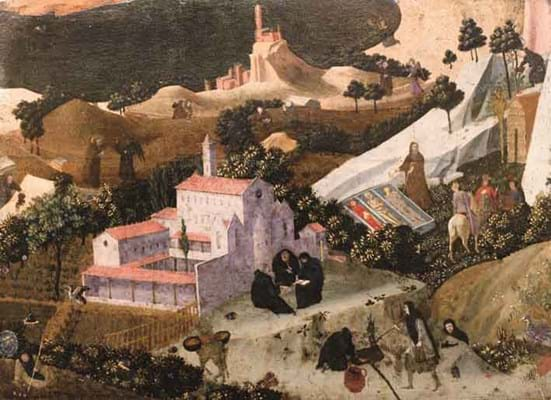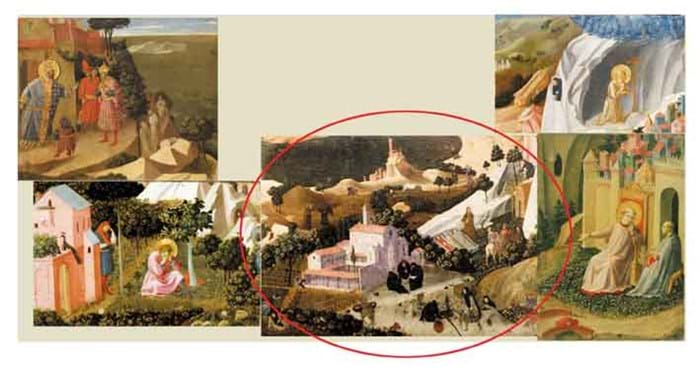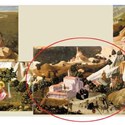They are offering an unpublished 11¼ x 15in (27.5 x 38.5cm) tempera on panel painting that has been in the same French family since the 19th century and is attributed to the Florentine artist Fra Angelico and his workshop, c.1430-35.
It was identified in 2001 by the Italian Renaissance painting expert Michel Laclotte as one of six sections from an early 15th century Florentine panel painting measuring approximately 18in x 3ft (46 x 92 cm) and featuring a complex monastic iconography.
At some point, probably in the late 18th or early 19th century, this large work was cut into sections, probably for sale. Four of the others are now in museums around the world. The Apparition of St Romuald to Othon III is in the Musée de Beaux Arts in Antwerp; St Benedict in the Desert is in the Musée Condé in Chantilly; The Conversion of Saint Augustine is in the Musée Thomas Henry in Cherbourg and The Offering of the Papacy to Saint Gregory or Celestine is in the Philadelphia Museum of Art.
The connection between the four emerged very gradually over the course of the past century as museum curators and academic experts in the field gradually became convinced that these four dispersed panels were linked and formed part of one work. There has also been much academic discussion around an attribution of the work to Fra Angelico and his workshop.
An early opinion was that these formed a horizontal predella panel for a larger work. Later, however, expert opinion was revised to the idea of one large work with the pieces set out as in the reconstruction (see image 2).
Michel Laclotte's 2001 discovery in a collection in Southern France of the fifth section added a significant piece to the puzzle, supporting this arrangement and giving an important clue to the meaning of the reconstructed whole.
Its subject is not a figure group centring on an episode from the life of one saint; instead it takes the form of a Thébaïde, a landscape populated with scenes from hermit life in the Egyptian desert around Thebes.
The Thébaïde was a popular Florentine subject in early Renaissance painting and there is another famous version by Fra Angelico painted in a frieze-like form, now in the Uffizi.
This fifth landscape panel is reckoned to be the central section with the four museum works placed around it thought to represent fathers of the church and founders of orders (though not all experts agree on their identification).
Evidence Compiled
The auctioneers have produced a 64-page illustrated catalogue which details the stages by which the theory linking these panels evolved, together with the scholastic and scientific evidence that supports the theory.
That evidence includes matching up different details within the works. For example, the townscape in the lower right-hand section of the Chantilly St Benedict, which was revealed after cleaning, proved to be a continuation of the town in the upper right section of the Philadelphia St Gregory. Similarly, the tree and rock in the St Augustine panel continue into the lower part of the St Romauld panel.
In addition there are horizontal and vertical cracks that are common to different panels while cracks and wood fibres have been examined radiographically and seen to join up.
There are also similarities in the painting style of the different panels and in the use of colour and the treatment of details which further support the theory.
How much of the work can be attributed to the hand of the master and how much to his workshop remains subject to discussion and is thought to vary between the constituent elements.
Four of the five panels also have a shared history up to the early 19th century when, according to known documentary evidence, they were all in France. The whereabouts of the sixth fragment is not known.
The Leclere Thébaïde panel, which is described as having restorations, is on view in Paris by appointment until October 20. It will be sold by Leclere in Marseille on Saturday, October 27.
The estimate for this fascinating element of an early Renaissance jigsaw puzzle has been set at €200,000-400,000.
In 2007, a pair of panels of Dominican saints that had formed part of Fra Angelico's high altarpiece for the Church of San Marco that had been discovered in a house in Oxfordshire were offered at Duke's in Dorchester, selling for £1.7m against expectations of in excess of £1m.








